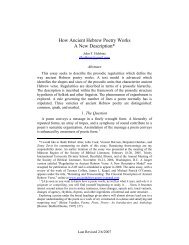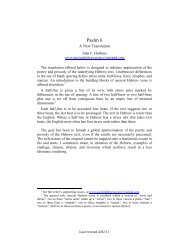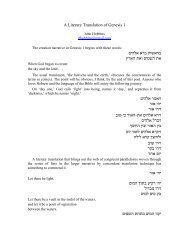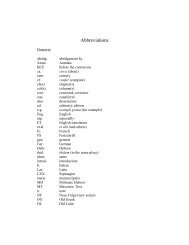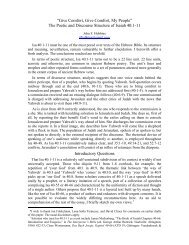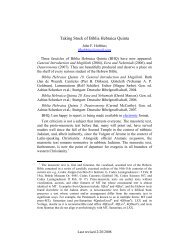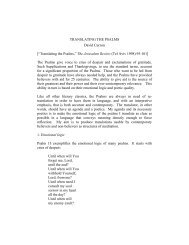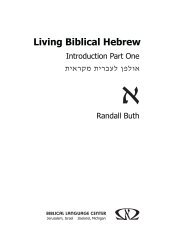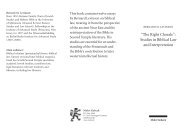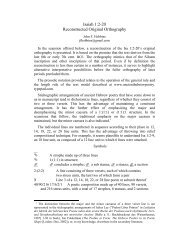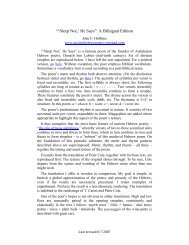Here - Ancient Hebrew Poetry - Typepad
Here - Ancient Hebrew Poetry - Typepad
Here - Ancient Hebrew Poetry - Typepad
- No tags were found...
Create successful ePaper yourself
Turn your PDF publications into a flip-book with our unique Google optimized e-Paper software.
9of a theory of stress parallelisms anticipates the interest in syntax thatcharacterizes the more recent work of Collins and O’Connor. Alterreferences John Bright, whose exposition of the Ley-Sievers system asemployed in his generation remains the most lucid available in the Englishlanguage. The work of George Buchanan Gray, Hans Wildberger, LuisAlonso Schökel, and Leslie Allen might also be singled out. All applied thestress-counting method to a large corpus of texts in a consistent manner. 19Harshav, Alter, and Berlin refine and rework the classical descriptiongoing back to Lowth. Harshav and Alter reclaim the method of primarystress analysis associated with the names of Julius Ley and Eduard Sievers. 20If they are right to do so, we may still pose the question: What about thework of those who reject the description of parallelism as the hallmark ofancient <strong>Hebrew</strong> poetry and forgo the search for prosodic regularities therein?Is the work of those who set the classical description aside nonethelesscompatible with it?Collins, Kugel, and O’ConnorTerence Collins’ description of line-forms in <strong>Hebrew</strong> poetry, as heremarks, “can be looked on as a system of measurement, determining what isa well formed verse-line and thus performing the same function as the more19 Joachim Begrich, “Zur hebräische Metrik,” TRu NF 4 (1932) 67-89; “Der Satzstil imFünfer,” ZS 9 (1933-34) 169-209; repr. idem, Gesammelte Studien zum Alten Testament (ed.Walther Zimmerli; TB 21; Munich: Chr. Kaiser, 1964) 132-67; John Bright, Jeremiah (AB21; New York: Doubleday, 1965) cxxvi-cxxxviii; George Buchanan Gray (The Forms of<strong>Hebrew</strong> <strong>Poetry</strong> [London: Hodder & Stoughton, 1915; repr. Eugene: Wipf & Stock, 2002)];idem, Isaiah I-XXXIX [chs. 1-27 alone are covered] [ICC; Edinburgh: T & T Clark, 1912];Samuel R. Driver and George B. Gray, Job [Gray is responsible for the discussion ofrhythms in the introduction and notes] [ICC; Edinburgh: T & T Clark, 1912]); Luis AlonsoSchökel, Estudios de poética hebrea (Barcelona: Juan Flors, 1963) 165-88 [Isa 1-21]; 188-89 [Isa 43-44]; 451-87 [Isa 24-27]; 489-523 [Isa 28-30]; Hans Wildberger, Jesaja: 1.Teilband: Jesaja 1-12 (2d ed., BKAT 10/1; Neukirchen-Vluyn: Neukirchener Verlag, 1980[ET Isaiah 1-12 (CC; Minneapolis: Fortress, 1990)]; idem, Jesaja: 2. Teilband: Jesaja 13-27(BKAT 10/2, Neukirchen-Vluyn: Neukirchener Verlag, 1978 [ET Isaiah 13-27 (CC;Minneapolis: Fortress, 1997)]; idem, Jesaja: 3. Teilband: Jesaja 28-39 (BKAT 10/3;Neukirchen-Vluyn: Neukirchener Verlag, 1982 [ET Isaiah 28-39 (CC; Minneapolis:Fortress, 2002)]; Leslie C. Allen, Psalms 101-150 (2d ed.; WBC 21; Nashville: ThomasNelson, 2002).20 Where Ley and Sievers differ, Ley’s approach seems of more enduring value. See thewriter’s “Meter in <strong>Ancient</strong> <strong>Hebrew</strong> <strong>Poetry</strong>: A History of Modern Research,”ancienthebrewpoetry.typepad.com.



